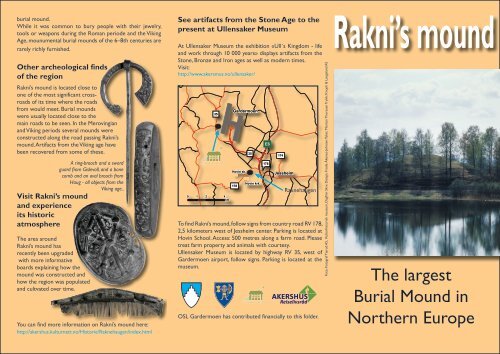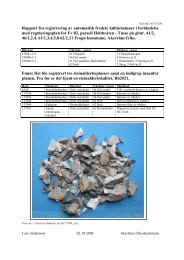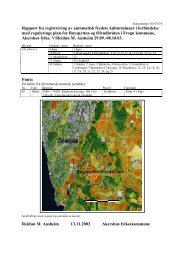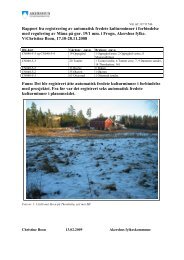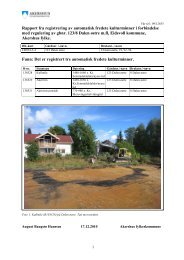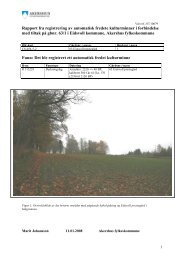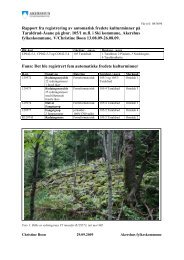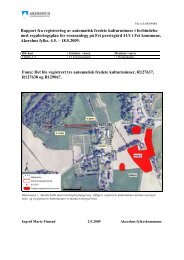The largest Burial Mound in Northern Europe - Kulturnett Akershus ...
The largest Burial Mound in Northern Europe - Kulturnett Akershus ...
The largest Burial Mound in Northern Europe - Kulturnett Akershus ...
You also want an ePaper? Increase the reach of your titles
YUMPU automatically turns print PDFs into web optimized ePapers that Google loves.
urial mound.<br />
While it was common to bury people with their jewelry,<br />
tools or weapons dur<strong>in</strong>g the Roman periode and the Vik<strong>in</strong>g<br />
Age, mounumental burial mounds of the 6–8th centuries are<br />
rarely richly furnished.<br />
Other archeological f<strong>in</strong>ds<br />
of the region<br />
Rakni’s mound is located close to<br />
one of the most significant crossroads<br />
of its time where the roads<br />
from would meet. <strong>Burial</strong> mounds<br />
were usually located close to the<br />
ma<strong>in</strong> roads to be seen. In the Merov<strong>in</strong>gian<br />
and Vik<strong>in</strong>g periods several mounds were<br />
constructed along the road pass<strong>in</strong>g Rakni’s<br />
mound. Artifacts from the Vik<strong>in</strong>g age have<br />
been recovered from some of these.<br />
Visit Rakni’s mound<br />
and experience<br />
its historic<br />
atmosphere<br />
<strong>The</strong> area around<br />
Rakni’s mound has<br />
recently been upgraded<br />
with more <strong>in</strong>formative<br />
boards expla<strong>in</strong><strong>in</strong>g how the<br />
mound was constructed and<br />
how the region was populated<br />
and cultvated over time.<br />
A r<strong>in</strong>g-brooch and a sword<br />
guard from Gislevoll, and a bone<br />
comb and an oval brooch from<br />
Haug - all objects from the<br />
Vik<strong>in</strong>g age..<br />
You can f<strong>in</strong>d more <strong>in</strong>formation on Rakni’s mound here:<br />
http://akershus.kulturnett.no/Historie/Raknehaugen/<strong>in</strong>dex.html<br />
See artifacts from the Stone Age to the<br />
present at Ullensaker Museum<br />
At Ullensaker Museum the exhibition «Ull´s K<strong>in</strong>gdom - life<br />
and work through 10 000 years» displays artifacts from the<br />
Stone, Bronze and Iron ages as well as modern times.<br />
Visit:<br />
http://www.akersmus.no/ullensaker/<br />
¯<br />
35<br />
"® P<br />
0 1 2 4<br />
km<br />
Gardermoen<br />
"® P<br />
E<br />
Hov<strong>in</strong> sk. P<br />
P<br />
178<br />
To f<strong>in</strong>d Rakni’s mound, follow signs from country road RV 178,<br />
2,5 kilometers west of Jessheim center. Park<strong>in</strong>g is located at<br />
Hov<strong>in</strong> School. Access: 500 metres along a farm road. Please<br />
treat farm property and animals with courtesy.<br />
Ullensaker Museum is located by highway RV 35, west of<br />
Gardermoen airport, follow signs. Park<strong>in</strong>g is located at the<br />
museum.<br />
AKERSHUS<br />
F YOSL L K E S KGardermoen O M M U N E has contributed f<strong>in</strong>ancially to this folder.<br />
35<br />
Hov<strong>in</strong> krk.<br />
E6<br />
178<br />
174<br />
Jessheim<br />
Raknehaugen<br />
Foto: Fotograf Tærud AS, Kulturhistorisk museum, Dagf<strong>in</strong>n Skre Design: Frode Åkenes-Johnsen Tekst: Morten Thoresen Trykk: Knoph & Langeland AS<br />
Rakni’s mound<br />
<strong>The</strong> <strong>largest</strong><br />
<strong>Burial</strong> <strong>Mound</strong> <strong>in</strong><br />
<strong>Northern</strong> <strong>Europe</strong>
Rakni’s mound – A symbol of power and dom<strong>in</strong>ion<br />
This monumental barrow is located close to the center<br />
of Jessheim and Gardermoen airport, only 6 kilometers<br />
from highway E6. <strong>The</strong> mound is larger than any other<br />
burial mound <strong>in</strong> northern <strong>Europe</strong> and its construction<br />
is also exceptional; between soil and sand, 75000 logs<br />
are piled <strong>in</strong> three pyramid shaped layers.<br />
From Sigurd Grieg’s excavation <strong>in</strong> 1939-40. Grieg discovered a layer of<br />
coal at the centre of the mound conta<strong>in</strong><strong>in</strong>g fragments of a human skull.<br />
<strong>The</strong> person had been cremated, and it is unknown if the whole body or<br />
the skull only was buried here.<br />
<strong>The</strong> Migration and Merov<strong>in</strong>gian periods<br />
Rakni’s mound is located close to an ancient center of power.<br />
However, the first settlement <strong>in</strong> the area dates back to the<br />
Neolithic period, more than 2800 years BC.<br />
<strong>The</strong> name of the area - Romerike - orig<strong>in</strong>ates from the<br />
ancient Raumaricii. <strong>The</strong> end<strong>in</strong>g of the name suggests that it<br />
was a petty k<strong>in</strong>gdom dur<strong>in</strong>g the Migration and Merov<strong>in</strong>gian<br />
periods. <strong>The</strong> local k<strong>in</strong>g would rule over the people, and <strong>in</strong><br />
return he would ma<strong>in</strong>ta<strong>in</strong> law and order and provide millitary<br />
protection.<br />
Farm<strong>in</strong>g and the aristocracy<br />
In the aerial photography to<br />
the right, a longhouse and<br />
several smaller mounds<br />
located close to Rakni’s<br />
mound is visible. <strong>The</strong><br />
archeologists believe that<br />
the long house is 50 to 200<br />
years older than the burial mound. At this<br />
time (the Late Roman and Migration periods)<br />
the area was already <strong>in</strong>tensively cultivated.<br />
<strong>The</strong> smaller mounds were constructed later<br />
than both the longhouse and Rakni’s mound.<br />
Key facts about Rakni’s mound:<br />
•<strong>The</strong> orig<strong>in</strong>al height was more than<br />
18 meters and the diameter about 77<br />
meters<br />
•<strong>The</strong> log construction consists of<br />
approximately 75 000 logs<br />
•<strong>The</strong> burial mound was built dur<strong>in</strong>g one<br />
w<strong>in</strong>ter and summer, some time between<br />
533-551 AD<br />
•<strong>The</strong> mound conta<strong>in</strong>s the grave of one<br />
cremated person<br />
•<strong>The</strong> person was 20-40 years old<br />
From top: wooden spade found <strong>in</strong> the<br />
mound. A key and glass and bronze beads from<br />
mounds <strong>in</strong> the Sandshaugen area. <strong>The</strong> artifacts<br />
are dated to the Merov<strong>in</strong>gian period, 600-700<br />
AD. Below: an axe dated to the Vik<strong>in</strong>g age 900 AD,<br />
found at Gislevoll.<br />
<strong>The</strong> longhouse located close to Rakni’s mound was probably a guildhall,<br />
a place where the local petty k<strong>in</strong>g would welcome guests and host<br />
banquets for the aristocracy.<br />
We know when the mound was built, but<br />
do we know why?<br />
Tree-r<strong>in</strong>g analyses and radio carbon dat<strong>in</strong>g of the logs have<br />
been carried out. <strong>The</strong>y tell us that all the logs, ma<strong>in</strong>ly p<strong>in</strong>e<br />
trees, were logged dur<strong>in</strong>g one s<strong>in</strong>gle year. Why do people<br />
commence such a monumental project? Folklore recounts<br />
the story of a big 6th century battle at Ste<strong>in</strong>sjordet (the<br />
stony field) close to the burial mound. K<strong>in</strong>g Rakni and his<br />
four sons were killed there. <strong>The</strong> k<strong>in</strong>g was buried <strong>in</strong> his armor<br />
between two white horses <strong>in</strong> the mound and his sons were<br />
buried close to Hov<strong>in</strong> church. What are the archeologists<br />
say<strong>in</strong>g?<br />
Rakni’s mound has been excavated three<br />
times by archeologists<br />
<strong>The</strong> mound was <strong>in</strong>vestigated at the end of the 18th century<br />
and dur<strong>in</strong>g the period 1939-40. It was however not until<br />
1990 the cremated human rema<strong>in</strong>s were positively identified<br />
and one could conclude that Rakni’s mound <strong>in</strong> fact was a<br />
ca 10 000 BC 3 800 BC 1 800 BC 500 BC AD 400 AD 570 AD 800 AD 1030 AD<br />
1537 AD<br />
Mesolithic Neolithic Bronze Age Pre-Roman Iron Age Roman Iron Age Migration Period Merov<strong>in</strong>gian Period Vik<strong>in</strong>g Age Middle Ages


